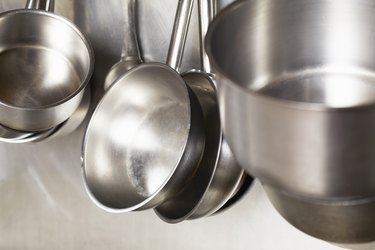
Stainless steel is one of the safest and most versatile materials for cookware. Though it is made to be long-lasting, your stainless steel cookware may end up with burned-on stains if you forget it on the stove or the pan overheats. Fortunately, there are many methods for removing burns and common discoloration from stainless steel. While there are commercial products like Barkeepers Friend and Carbon Off that can be used, there are also many things right in your kitchen that can take care of tough burned-on stains.
Vinegar and Baking Soda
Video of the Day
Both of these substances are commonly used for cheap, eco-friendly cleaning, and they can be useful for pans left to overheat on the stove. Vinegar contains acetic acid, which helps it break down burnt-on stains, while baking soda is a gentle abrasive, which helps it scrub away stains. The two substances also react together to form a fizzy substance that helps break down and lift away burned-on particles.
Video of the Day
To clean a stainless steel pan with vinegar and baking soda, fill the bottom of your stainless steel pan with enough water to cover the stained areas, then add 1 cup of white vinegar. Bring the mixture to a boil, then remove from the heat. Let the pan and mixture cool until they're safe to touch, then pour the vinegar mixture out.
Make a thick paste from baking soda with a little water and rub it into the stained areas with a sponge. You can also rub the paste all over the rest of the pan to restore some shine. Place the pan upside down on a paper towel until the paste dries. Make another helping of water and vinegar mixture, and rinse the dried baking soda paste off with that. Finally, rinse off the pan with plain water and let it dry.
Lime and Salt
This is another combination of an acid and an abrasive that can mend a seemingly ruined stainless steel pan, according to Webstaurant Store. Cut a lime in half and cover the burned area with lime juice (or you can use lime juice from a bottle, but either way you'll be using the halved lime later). Then, cover the area generously with coarse kosher salt.
Let the mixture sit for several minutes, then sprinkle on more salt (some of it will have dissolved). Before the additional salt has a chance to dissolve, take the lime half and use it to scrub the juice and salt mixture into the burn-on stains. Rinse with water and let dry.
Cream of Tartar
Cream of tartar contains potassium hydroxide and tartaric acid and is also an abrasive, all of which make it a good cleaning agent for the job. Mix a tablespoon of it with a cup of water and bring that to a boil.
Allow it to cool, empty the pan, then scrub a thick paste of cream of tartar with a little water over the burned area. Let it sit overnight, then wash and rinse in the morning.
Dryer Sheet Remedy
If you don't mind the chemicals in dryer sheets, then this is another good solution for a burn on your pan. Fill the pan with warm water and soak a dryer sheet in it. Be sure to push it under the water to make sure it's completely saturated.
Let it sit for a couple of hours, then use the dryer sheet to scrub the burned areas. The detergents in the dryer sheet should have loosened the burnt-on stains.
Cola for Ruined Stainless Steel Pan
Cola is carbonated and very acidic and can be very effective against stubborn stains, like burned caramel. Bring some cola to a gentle simmer in the pan, then gently scrape off the burnt-on food. As Cookware Talk explains, club soda will serve the same purpose.
Stainless Steel Maintenance
Finally, a little maintenance goes a long way. To keep your pans shiny and safe, avoid the following:
- Adding salt to water before it boils. This can cause pitting corrosion to the bottom of the pan.
- Adding cold food directly to a hot pan. Cold food is more likely to stick to the pan, so bring cold foods to room temperature before cooking them.
- Using cold water to clean a hot pan. This can cause warping and disfiguration.
- Using steel wool or other harsh scrubbing tools. This can scratch the surface.